Attached files
| file | filename |
|---|---|
| 8-K - FORM 8-K - Howmet Aerospace Inc. | d8k.htm |
Exhibit 99
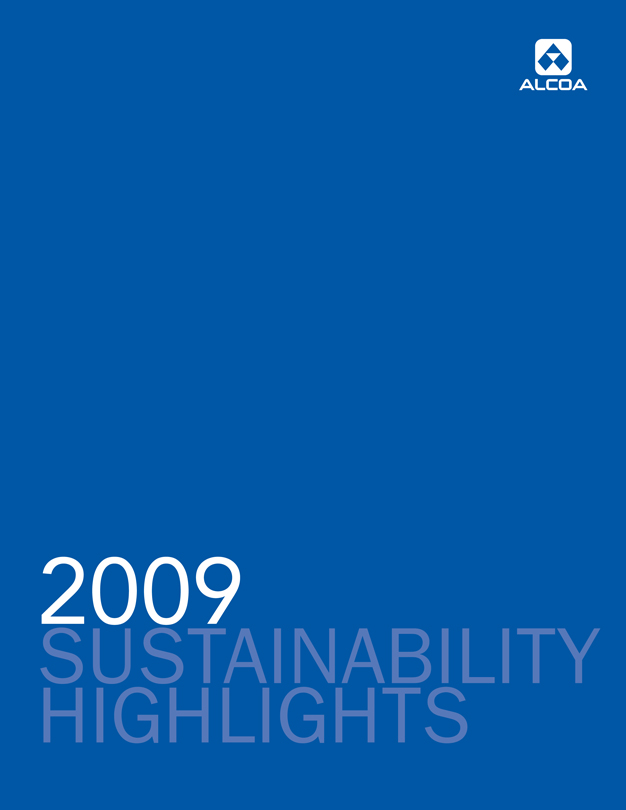
Table of Contents
| CHAIRMAN AND CEO STATEMENT |
1 | |
| SUSTAINABILITY APPROACH |
3 | |
| STRATEGIC SUSTAINABILITY TARGETS |
5 | |
| SUSTAINABILITY OF PRODUCTS |
9 | |
| SUSTAINABILITY OF RESOURCES |
12 | |
| SUSTAINABILITY OF OPERATIONS |
15 | |
ABOUT ALCOA
Alcoa is the world’s leading producer of primary aluminum, fabricated aluminum and alumina. Among the solutions we market are flat-rolled products, hard alloy extrusions, and forgings, as well as Alcoa® wheels, fastening systems, precision and investment castings, and building systems. We also have expertise in other light metals, such as titanium and nickel-based super alloys.
Forward-Looking Statements
Certain statements in this report relate to future events and expectations and, as such, constitute forward-looking statements within the meaning of the Private Securities Litigation Reform Act of 1995. Forward-looking statements include those containing such words as “anticipates,” “believes,” “estimates,” “expects,” “hopes,” “targets,” “should,” “will,” “will likely result,” “forecast,” “outlook,” “projects,” or similar expressions. All statements that reflect Alcoa’s expectations, assumptions or projections about the future other than statements of historical fact are forward-looking statements, including, without limitation, forecasts concerning aluminum industry growth or other trend projections, anticipated financial results or operating performance, and statements about Alcoa’s strategies, objectives, goals, targets, outlook, and business and financial prospects. Forward-looking statements are subject to a number of known and unknown risks, uncertainties, and other factors that may cause Alcoa’s actual results to differ materially from those expressed or implied in the forward-looking statements. Alcoa disclaims any intention or obligation to update publicly any forward-looking statements, whether in response to new information, future events or otherwise, except as required by applicable law.
Some of the important factors that could cause actual results to differ materially from those in the forward-looking statements include: uncertainties regarding the strength, pace, or sustainability of a recovery from the global economic downturn, the risk of another downturn, and the impact on Alcoa; material adverse changes in aluminum industry conditions generally, including global supply and demand conditions and fluctuations, including sustained declines or further deterioration, in London Metal Exchange-based prices for primary aluminum; material adverse changes in the markets served by Alcoa, including the transportation, building and construction, distribution, packaging, industrial gas turbine, and other markets; Alcoa’s inability to achieve the level of cash conservation, cash generation, cost reductions, debt-to-capital ratio, return on capital or productivity improvements, or earnings or revenue growth anticipated by management; significant increases in power or energy costs (e.g., electricity, natural gas, and fuel oil), or interruption or unavailability of energy supplies; significant increases in the costs of other raw materials, including carbon products, caustic soda, and other key inputs, or significant lag effects for decreases in commodity- or LME-linked costs of production; continued volatility or deterioration in the financial markets, or the failure of financial institutions to fulfill their commitments to Alcoa under committed credit facilities; downgrades in Alcoa’s credit ratings, material increases in Alcoa’s cost of borrowing or an inability to access the credit or capital markets; operating factors such as supply disruptions, or failure of equipment or processes to meet specifications; Alcoa’s inability to successfully implement as planned, or to realize expected benefits from, its growth projects in Brazil, China, and Russia or its portfolio streamlining strategy, including divestitures of non-core businesses; Alcoa’s inability to successfully realize short-term benefits from changes in its pricing strategy for the aluminum can sheet market; risks associated with the international joint ventures and other strategic alliances in which Alcoa participates, including the joint venture with Ma’aden, the Saudi Arabian Mining Company; political and economic risks associated with foreign activities, including fluctuations in foreign currency exchange rates or changes in the laws or governmental regulations or policies in the countries in which Alcoa operates; outcomes of significant legal proceedings or investigations, changes in law or other contingencies that cannot be predicted with certainty; adverse effects or uncertainties regarding the impacts of climate change, climate change regulations or greenhouse effects; significant costs and liabilities associated with numerous complex and increasingly stringent environmental laws and regulations; adverse changes in Alcoa’s relationships with, or a significant downturn in the business or financial condition of, key customers or suppliers; union disputes and other employee relations issues; potential negative effects on Alcoa’s business and growth prospects as a result of reductions in its capital expenditures; and the other risk factors summarized in Alcoa’s Annual Report on Form 10-K for the year ended December 31, 2009 and other SEC reports.
| Visit www.alcoa.com/sustainability for more information on policies, programs, actions, and performance data. |
Chairman and CEO Statement
Throughout 2009, our industry and company experienced the most challenging economic environment that many of us can recall. Faced with a triple threat—aluminum prices crashing, broad demand destruction within our customer base, and a credit crunch that crippled our ability to initiate growth—we quickly executed our Cash Sustainability Program to strengthen our balance sheet, restore liquidity, and make Alcoa free-cash-flow neutral by the end of 2009.
The results were nothing short of dramatic. Working together, Alcoans from all over the world met every single program target and, in some cases, over-delivered.
Even with so much of our focus on financial sustainability during 2009, we never wavered from our commitments to environmental excellence and social responsibility.
We took a major step forward in 2009 to integrate all aspects of our sustainability agenda into our core business strategy. I commissioned an executive-level team to guide this integration throughout all of our businesses, focusing on our carbon and energy footprint, the life cycle of our products, and opportunities for innovations to offer sustainable solutions for our customers.
We have organized our 2009 Sustainability Report around three areas: the sustainability of our products, our resources, and our operations. We hope this new structure and approach will make it easier for our stakeholders to understand how Alcoa approaches sustainability.
Setting sustainability goals and publicly reporting our results have been our priorities since 1993. This year, we reviewed all of the targets we had set for ourselves in our 2020 Strategic Framework for Sustainability. In some cases where we had surpassed earlier targets, we set the bar higher for the next 10 to 20 years. We took a fresh look at other targets, ensuring that we are focusing on the right metrics at the right time. In our revised strategic sustainability targets, we continue to challenge ourselves with aggressive targets, higher expectations, and a broader mindset about incremental improvement among our employees.
We are very proud of what we have accomplished during the past challenging year, and we are mindful that some of our improvements resulted from production curtailments in addition to technology and process improvements. Where possible, we distinguish between the two in this report. In some cases, we have introduced intensity data, along with absolute data, to ensure that our stakeholders understand the differences. We don’t take credit for marginal improvements that are tied to curtailments, and it is our goal to restart this valuable idled capacity when overall market conditions warrant.
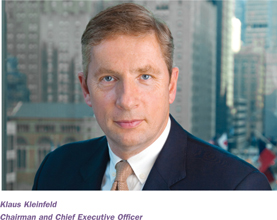
Some areas where we made demonstrative progress in 2009 include the following:
| • | Climate Change: Through process improvements in our Global Primary Products Group, we reduced direct greenhouse gas emissions by 1 million metric tons over 2008 levels. |
| • | Safety: We ended 2009 with 41.2% of our locations reporting zero lost workdays and 73.5% with no recordable injuries—a marked improvement over our 2008 performance; |
| • | Stakeholder Engagement/Community: About 90% of our worldwide operating locations now have community programs, and Alcoa and Alcoa Foundation invested more than US$34 million in the communities in which we operate worldwide; |
| • | Employee Engagement: We improved worldwide employee engagement scores in our Global Voices Survey, and 37% of our global employees participated in community service projects during our October Month of Service; |
| • | Sustainable Development: Dr. Mohammad Zaidi, Alcoa’s executive vice president and chief technology officer, co-chaired the World Business Council for |
1
Chairman and CEO Statement
| Sustainable Development’s Vision 2050 Initiative—a strategic, long-range, global sustainability project; and |
| • | Ethics: In early 2010, we took the top spot in the Basic Resources category in the respected Covalence Ethical Rankings, and we placed eleventh in ethical performance out of the 581 companies tracked—across all industries. |
Despite these positive developments, in 2009 we experienced four fatalities in our global operations. This is a huge tragedy for every Alcoan and frustrating to all of us who work so hard to eliminate fatality risks and preserve the life and safety of our colleagues and contractors. We will continue to focus resolutely on fatality prevention and the elimination of all associated risks.
In the pages of this 2009 Sustainability Report, I hope you experience the Alcoa that I see every day as CEO. During these tough economic times, we recommitted ourselves to integrating sustainability as a core value for Alcoa; protecting the health and well-being of our employees and our communities; conducting business with the highest code of ethics; preserving the environment and our natural resources; and earning our license to operate each and every day.
It is in this spirit that Alcoa recently became a signatory to the United Nations Global Compact and pledged to advance goals related to the environment, human rights, labor standards, and anti-corruption, as well as report on our progress.
I see an amazing future for Alcoa. Strong, lightweight, energy-saving and infinitely recyclable, our miracle metal will continue to contribute to the sustainable life and health of our planet and its people.
Our stakeholders always have a strong voice in our sustainability performance and how we report it. Please email us at sustainability@alcoa.com to let us know what you think and how we can improve.

|
| Klaus Kleinfeld |
| Chairman and Chief Executive Officer |
| Visit www.alcoa.com/sustainability for more information on policies, programs, actions, and performance data. | ||
| 2 |
Sustainability Approach
At Alcoa, sustainability is defined as using our values to build financial success, environmental excellence, and social responsibility in partnership with all stakeholders in order to deliver net long-term benefits to our shareowners, employees, customers, suppliers, and the communities in which we operate.
We are committed to regularly reviewing our sustainability performance, and we have been setting goals and publicly reporting our results against them since 1993 to be fully transparent with respect to our sustainability issues and progress and to provide significant information to all of our stakeholders.
Independent reviews of our sustainability reporting in 2007 and 2008 revealed a gap in our sustainability approach— we had not fully integrated sustainability into our core business strategies. We began to work in earnest in early 2009 to respond to that independent input.
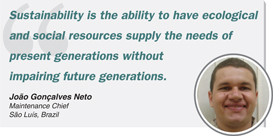
Our first task was to reevaluate how we were thinking about sustainability within Alcoa to ensure that our approach was well-aligned with how we were running our businesses. We wanted to be sure that all of our business units clearly understood how sustainability would be integrated into their core business strategies. We also wanted to ensure that stakeholders would understand how sustainability was linked to our business strategies.
We developed a new approach for sustainability during 2009 and reconstructed our sustainability reporting in conjunction with this new approach. The approach views sustainability through three different but interdependent lenses: sustainability of our products, sustainability of our resources, and sustainability of our operations.
We also commissioned a Global Sustainability Committee during 2009 consisting of key sustainability-focused Alcoa resources from various regions of the world. We tasked that committee to undertake a gap analysis regarding our current sustainability initiatives and priorities and develop an action plan for 2010 and beyond.
Finally, our CEO commissioned an executive-level Global Sustainability Steering Team to drive accountability for integration of sustainability into our business strategies. This team consists of key executives who now have accountability for Alcoa’s strategic sustainability initiatives, and they report on progress against our strategic sustainability priorities at every quarterly business review.
As their first order of business, team members reviewed the goals and objectives in our existing 2020 Strategic Framework for Sustainability and developed a new set of targets to drive progress in our businesses to 2020 and, for some areas, to 2030. In conjunction with the new sustainability approach, the new strategic sustainability targets will continue to drive us toward measurable results against our key sustainability challenges, such as climate change.
As a result of these actions, our longstanding commitment to sustainability became even stronger during 2009. We believe that linking sustainability to our core business strategies makes us a better company, and a better company becomes a company of choice for governments and communities. This designation leads to better access to land, markets, capital, resources, and people.
Our goal for 2010 and beyond is to seamlessly integrate sustainability concepts into all of our business processes so they become part of how we do business. Key components to achieving this goal are understanding the expectations of our stakeholders and remaining transparent in reporting our progress, as well as our setbacks.
Many of our business units and regions are employing complementary sustainability indicators around their sustainability challenges. They are also using workshops and other methods to engage customers, management, employees, communities, and other stakeholders in sustainability initiatives, leading to strategies and action plans.
We were recognized for our sustainability efforts in 2009 through inclusion in the Dow Jones Sustainability Index for the eighth consecutive time and being named one of the most sustainable companies in the world at the World Economic Forum in Davos, Switzerland, for the fifth (2009) year.
3
Sustainability Approach (continued)
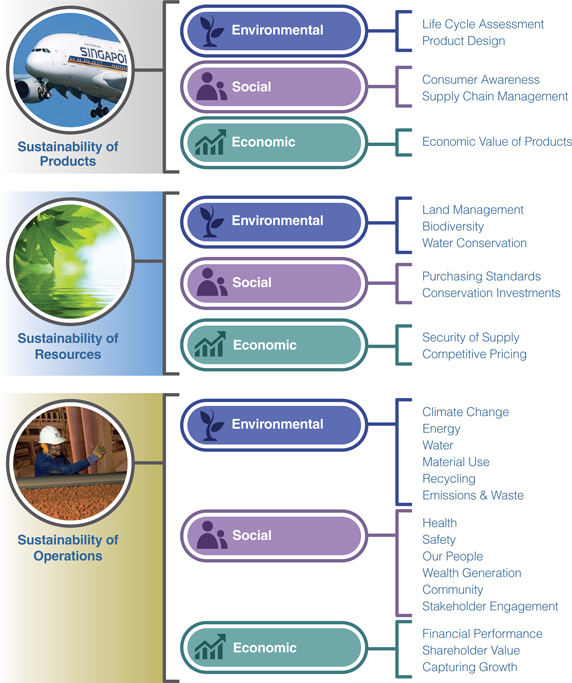
| Visit www.alcoa.com/sustainability for more information on policies, programs, actions, and performance data. | ||
| 4 |
Strategic Sustainability Targets
Initially developed in 2000 by an internal worldwide team that analyzed environmental and social trends since 1990 and looked 20 years into the future, Alcoa’s 2020 Strategic Framework for Sustainability has since evolved into a set of strategic targets for our businesses and locations to integrate all aspects of sustainability into their day-to-day operations.
The initial short- and long-term targets were agreed upon with the business leaders and technical experts throughout the company. The targets were very aggressive and designed to stretch the organization to think differently to drive optimum performance, as opposed to conservative objectives that we would be fairly certain we would meet.
We met or exceeded several of these very aggressive targets, but we also realized that we would fall short of others, especially those regarding resource efficiency. As such, our new Global Sustainability Steering Team reviewed the existing environment, health, and safety (EHS) targets and objectives in 2009 and developed a new set to drive progress in our businesses to 2020 and, for some areas, to 2030. These new EHS targets were approved by our executive and business-unit leadership in early 2010. We intend to review all other sustainability targets in 2010, and we will consider new targets in areas where we don’t have any today.
STRATEGIC SUSTAINABILITY TARGETS
| EXISTING TARGETS |
PROGRESS ACHIEVED THROUGH YEAR-END 2009 |
NEW TARGETS | ||
| Sustainability of Resources | ||||
| Achieve a five-year average mine land disturbance/mine rehabilitation ratio of 0.75:1.0 by 2020; 1:1 by 2030.
From a 2005 baseline, 20% reduction in bauxite residue land requirements per million metric tons of alumina produced by 2020; 40% by 2030.
Rehabilitate 20% of total residue storage area by 2020; greater than 40% by 2030.
Recycle or reuse 15% of residue generated by 2020; 30% by 2030. | ||||
| From base year 2000, a 50% reduction in landfill waste by 2007; 75% reduction by 2010; 100% reduction by 2015. | 70% | Recycle or reuse 75% of remaining waste streams by 2020; 100% by 2030. | ||
| Develop biodiversity plans for key locations by 2015. | ||||
| Sustainability of Operations | ||||
| From base year 1990, a 25% reduction in direct greenhouse gas emissions by 2010. Assuming success with the inert anode technology, a 50% reduction by 2010. | 44% | From a 2005 baseline, 20% reduction in total (direct and indirect) carbon dioxide equivalent (CO2,e) intensity by 2020; 30% by 2030. | ||
| From base year 2000, reduce energy intensity by 10% by 2010. | While much has been done to reduce Alcoa’s overall energy consumption, the change in our business mix over the past 10 years has made normalized quantification of an intensity reduction extremely difficult. | From a 2005 baseline, 10% reduction in the energy intensity of primary operations by 2020; 15% by 2030. | ||
| From a 2005 baseline, 20% reduction in the energy intensity of all other businesses by 2020; 30% by 2030. | ||||
5
Strategic Sustainability Targets (continued)
| EXISTING TARGETS |
PROGRESS ACHIEVED THROUGH YEAR-END 2009 |
NEW TARGETS | ||
| Sustainability of Operations (continued) | ||||
| From base year 2000, a 60% reduction in process water by 2009; 70% by 2010. | 29% | From a 2005 baseline, 10% reduction in average water-use intensity in each business by 2020; 25% by 2030. | ||
| Zero process water discharge by 2020. | Initial efforts to control process water are being managed through the process water reduction target. | |||
| From base year 2005, a 10% reduction in selected material use by 2010. | Progress against this goal was limited to use of recycled material | |||
| 25% recycled aluminum content in fabricated products by 2010; 50% by 2020. | Ratio of purchased scrap to total fabricated product shipments was 30%. However, the total amount of recycled metal in our products is somewhat lower since a portion of the purchased scrap would have been included in primary ingot sold to third parties. | |||
| Increase the North American used beverage can recycling rate to 75% by 2015. | 54% | Increase the North American used beverage can recycling rate to 75% by 2015. | ||
| From base year 2000, a 60% reduction in sulfur dioxide (SO2) by 2010. | 54% | While we will no longer have a corporate goal for SO2, reducing these emissions will remain an area of focus for businesses and regions where they are still an issue. | ||
| 50% reduction in volatile organic compounds (VOCs) by 2008; 60% reduction by 2010. | 65% | While we will no longer have a corporate goal for VOCs, reducing these emissions will remain an area of focus for businesses and regions where they are still an issue. | ||
| 30% reduction in nitrogen oxides (NOx) by 2007; 50% reduction by 2010; 85% reduction by 2015. | 53% | While we will no longer have a corporate goal for NOx, reducing these emissions will remain an area of focus for businesses and regions where they are still an issue. | ||
| 80% reduction in mercury emissions by 2008; 90% reduction by 2010; 95% reduction by 2015. | 4% | From a 2005 baseline, 80% reduction in mercury emission intensity by 2020; 90% by 2030. | ||
| Zero fatalities. | 4 fatalities in 2009 | Zero fatalities. | ||
| Zero lost workday rate. | 0.13 lost workday incident rate | Zero lost workday rate. | ||
| Zero total recordable injuries. | 1.28 total recordable incident rate | A total recordable injury rate of 0.68 by 2020 and 0.19 by 2030.
By 2020, achieve a sustained Alcoa Self Assessment Tool rating of 100% Good or better in the following:
• Fatality Prevention
• Confined Space Entry
• Mobile Equipment Safety
• Fall Prevention
• Lock/Tag/Verify
• Molten Metal Safety
• Combustible Dust/Particulate Safety | ||
| Visit www.alcoa.com/sustainability for more information on policies, programs, actions, and performance data. | ||
| 6 |
Strategic Sustainability Targets (continued)
| EXISTING TARGETS |
PROGRESS ACHIEVED THROUGH YEAR-END 2009 |
NEW TARGETS | ||
| Sustainability of Operations (continued) |
||||
| Zero total recordable injuries. (continued) | 1.28 total recordable incident rate | By 2030, achieve a sustained Alcoa Self Assessment Tool rating of 100% Good or better in these additional categories: | ||
| • Electrical Safety | ||||
| • Contractor Safety | ||||
| • Machine Safeguarding | ||||
| • Combustion Safety | ||||
| Increase the closure rate for targeted fatality risks to 99% by 2020 and 100% by 2030.
Institutionalize the use of human performance tools and processes across the business units/regions to reduce the deviation potential to equal to or less than 2% (98% compliance rate) by 2020 and equal to or less than 1% (99% compliance rate) by 2030. | ||||
| From base year 2006, achieve at least a 20% reduction in the number of employees requiring protective measures against unacceptable workplace exposure to chemicals by 2008. | 35% | From a 2010 baseline, 50% reduction in the proportion of employees with exposure to chemical agents exceeding Alcoa occupational exposure limits (without regard to personal protective equipment) by 2020. | ||
| From base year 2006, achieve at least a 20% reduction in the number of employees requiring protective measures against unacceptable noise levels by 2008. | 22% | From a 2010 baseline, each location has achieved a total average annual rate of new hearing shifts of less than 1% by 2020. | ||
| All significant ergonomic risks have been identified, and at least 50% controlled, by 2020; significant risks not controlled will have action plans with costs and timelines for control. | ||||
| By 2020, each location has an active and informed process to address questions about health issues arising from the community and other external stakeholders. | ||||
| Number of employees participating in culture of health initiatives. | 96% of established locations had health promotion activities (We currently do not aggregate employee participation data at the corporate level.) | By 2020, achieve a 100% favorable response rate to the following questions on Alcoa’s annual employee survey: | ||
| • I work in an environment that promotes safety. | ||||
| • A culture of health exists within Alcoa | ||||
| • We do not compromise EHS values for the sake of production or profit. | ||||
| By 2010, the following representation at Alcoa’s management level: | • Global women: 17%
• U.S. minority: 13% |
By 2010, the following representation at Alcoa’s management level: | ||
| • Global women: 18% |
• Global women: 18% | |||
| • U.S. minority: 15% |
• U.S. minority: 15% | |||
| 100% of salaried employees receiving annual performance feedback. | 70% | 100% of salaried employees receiving annual performance feedback. | ||
7
Strategic Sustainability Targets (continued)
| EXISTING TARGETS |
PROGRESS ACHIEVED THROUGH YEAR-END 2009 |
NEW TARGETS | ||
| Sustainability of Operations (continued) |
||||
| By 2020, 100% of manufacturing locations will implement the Alcoa Community Framework. | 90% of worldwide operating locations had established community programs | By 2020, 100% of manufacturing locations will implement the Alcoa Community Framework. | ||
| 40% of employees within a business unit or region volunteered in the community through ACTION, Bravo!, or Month of Service. | ACTION: 18% Bravo!: 14% Month of Service: 37% |
40% of employees within a business unit or region volunteered in the community through ACTION, Bravo!, or Month of Service. | ||
| Debt-to-total capitalization consistently between 30% and 35%. | 38.7% | Debt-to-total capitalization consistently between 30% and 35%. | ||
| No material weaknesses in the design or operation of internal controls over financial reporting, which are reasonably likely to adversely affect Alcoa’s ability to record, process, summarize, and report financial information. | Alcoa continued to meet the goal of no material weaknesses in the design or operation of internal controls over financial reporting. | No material weaknesses in the design or operation of internal controls over financial reporting, which are reasonably likely to adversely affect Alcoa’s ability to record, process, summarize, and report financial information. | ||
| Resolution of 90% of cases reported on the Compliance Line within 12 working days by 2009. | Compliance Line calls related to employee relations issues, including those involving payroll or benefit determination issues, were resolved within 12 working days 63% of the time in 2009. Often, calls concerning more complex issues require considerably more time for thorough investigation and appropriate resolution. | At least 15% of Compliance Line closed calls result in a minimum of one process improvement. | ||
| Visit www.alcoa.com/sustainability for more information on policies, programs, actions, and performance data. | ||
| 8 |
| Sustainability of Products |

|
Sustainability is critical for Alcoa’s business success and for the success of our customers. Our products play a significant role in the continuing, sustainable life and health of our planet.
We are the world leader in the production and management of primary aluminum, fabricated aluminum, and alumina combined. In addition to aluminum products and components that include flat-rolled products, hard alloy extrusions, and forgings, we market Alcoa® wheels, fastening systems, precision and investment castings, and building systems.
Aluminum is one of the world’s most sustainable materials, with approximately 75% of the metal ever produced since 1888 still in use today. This metal offers significant benefits—high strength, light weight, and durability—that help our customers’ products become more sustainable as well.
At Alcoa, we are constantly focused on better understanding and improving the sustainability of our products. We are also involved in developing new and improved products and processes to increase both the amount of aluminum used throughout the world and that which can be recovered for recycling. In fact, aluminum is the most sustainable and recyclable automotive, packaging, and construction material in today’s market. Every time aluminum is recycled, it uses 95% less energy than when it was first made—preserving precious energy resources.
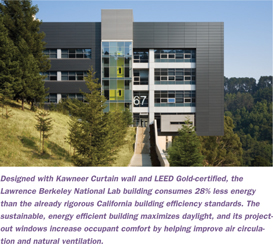
As part of our continuous-improvement efforts, we look at how we produce aluminum, the lifespan of its use in our customers’ products, and how it is recycled for future use. What we’ve found is that during a product’s life cycle, aluminum can improve energy efficiency and reduce carbon dioxide emissions, lessening our environmental footprint and that of our customers.
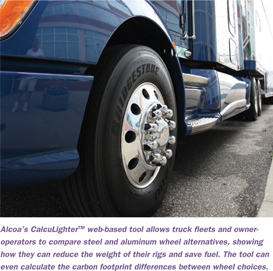
In today’s world, where the dominant trends are population growth, urbanization, and growth of energy demands, aluminum is an ideal material. Strong but lightweight, it is an essential component of green buildings in fast-growing urban areas. It improves fuel efficiency and emissions reductions in all modes of transportation. Because it is infinitely recyclable, it is the perfect material to reduce waste in overburdened landfills.
LIFE CYCLE ASSESSMENT
Measuring a product’s impact in terms of its environmental burdens, the energy and raw materials used to manufacture it, and the benefits associated with its use requires a careful analysis from cradle to grave. The most enlightened views require an analysis of cradle to cradle.
We are using life cycle assessments to guide decisions about improving existing products and processes and developing new ones. Product resource requirements, such as energy and materials, and the environmental consequences of the
9
Sustainability of Products (continued)
products are not always readily apparent without such a holistic analysis. Life cycle assessments can identify where we can save emissions and costs, as well as where our products can drive efficiency and make meaningful overall improvements.
We performed life cycle assessments on a number of aluminum-containing products in 2009, including computer laptops, automotive space frames, truck/trailers, city buses, and bottles. One assessment showed that more than 50 tons of carbon dioxide (CO2 ) emissions can be saved from every bus in China where substantial amounts of aluminum have been incorporated into the structural design and panels. Another indicated that at today’s recycle rates, aluminum beverage containers have lower carbon footprints than competing materials.
We have agreed to test a protocol being developed by the World Resources Institute and World Business Council for Sustainable Development for accounting and reporting greenhouse gas emissions across a product’s life cycle. The testing will use the Alcoa aluminum wheel as the pilot, and our learnings and results from the multi-month evaluation will contribute to the publication of final standards in late 2010.
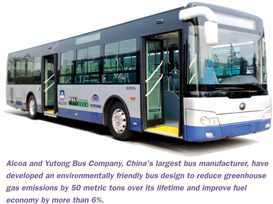
PRODUCT DESIGN
In 2009, we piloted a “design for sustainability” product strategy for consumer electronics at the Alcoa Technical Center. This initiative will enable us to:
| • | Design and develop integrated product solutions that are environmentally sustainable, simpler, and more cost effective to produce and take back at end-of-life; |
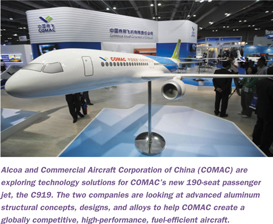
| • | Develop alloys, assembly/joining processes, and finishes that are more environmentally friendly and easier to recycle; and |
| • | Influence regulations in sustainability that impact product design and development. |
Two product pilots conducted for a laptop and a cell phone demonstrated the difference aluminum could make in the consumer electronics market. In the pilot involving the aluminum-intensive redesign of a laptop, recyclable material content significantly increased. Parts requiring end-of-life landfilling declined nearly 25%, and assembly time was greatly reduced due to parts consolidation. All efforts in this pilot project led to a reduction in the product’s net carbon footprint and use of natural resources. Similar results were achieved in the cell phone pilot.
Additional pilots will be conducted in 2010 to explore how sustainability aspects are incorporated in the early stage of product development for other Alcoa products.
CONSUMER AWARENESS
We have undertaken a number of initiatives to educate the public about both climate change and the sustainability of the products they purchase. We also are focused on increasing their participation in recycling products, particularly aluminum cans.
In 2009, we supported RecycleBank’s rewards-based recycling programs in Mesa, Arizona (USA), and Houston, Texas (USA), by funding the identification chips that are
| Visit www.alcoa.com/sustainability for more information on policies, programs, actions, and performance data. | ||
| 10 |
Sustainability of Products (continued)
placed on each residential recycling bin to determine rewards points. According to RecycleBank, preliminary results in Mesa showed a 36% increase in recycling volumes. In the first three months of collections in Houston, recycled volumes were up 141% from previous rates, with 78% of households participating.
We also have teamed up with U.S. organizations to distribute recycling bins to those who pledge to recycle. In 2009, 25,000 bins found their way to 18 states. An additional distribution of 50,000 bins is planned for 2010.
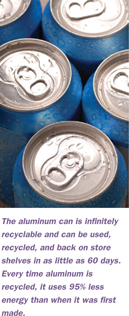
Our Make an Impact program in Australia and the United States is empowering our employees, their families, and their neighbors to actively reduce their carbon footprint.
By the end of 2009, more than 20% of our Australian workforce had signed on to make an impact, and the program is on track to reach 40% of our U.S. workforce by mid-2011. The program has helped families identify more than 907,185 kilograms (2 million pounds) of carbon dioxide savings through 2009, which is equivalent to US$900,000 in energy savings.
SUPPLY CHAIN MANAGEMENT
Integrating sustainability into Alcoa’s business strategies requires us to move in the direction of more sustainable suppliers.
During 2009, we initiated several programs in different regions of the world to better understand the potential alignment of our supply base to our key sustainability objectives. We also initiated a global corporate supplier sustainability program to begin that process with our strategic material and energy suppliers.
In 2010, we intend to pilot regional programs in Latin America and Canada and disseminate a supplier sustainability survey to our strategic raw material and energy suppliers. Where necessary, we also intend to offer training to suppliers so they can better align their sustainability initiatives with ours.
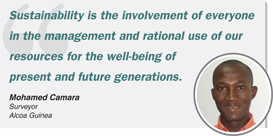
11
| Sustainability of Resources |

|
At the very front end of the aluminum-production process is the mining of bauxite, aluminum’s natural ore that is a mixture of silicon, iron, and aluminum oxides. Without bauxite, there would be no aluminum.
Alcoa mines bauxite in Jamaica, Suriname, Brazil, Guinea, and Australia. We send the mined bauxite to one of our refineries, where it is crushed and dissolved in a chemical solution to separate out the alumina. Alumina is the feedstock for smelting, where molten aluminum metal separates from the alumina.
Bauxite mining, which is done in relatively shallow pits, disturbs the land and disrupts its biodiversity. Bauxite refining creates waste in the form of bauxite residue, while smelting requires significant electricity and produces greenhouse gases and a waste known as spent pot lining.
Any industry that relies on natural resources, consumes the world’s energy resources, and creates waste materials and greenhouse emissions during its production process must confront the questions regarding its long-term sustainability.
The short answer is this. Aluminum is an essential nutrient for a green world, and it substantially improves the fuel efficiency of other products and reduces their greenhouse gas emissions. The benefits that aluminum provides to other products substantially outweigh its front-end impacts.
Recognizing the impacts of the front end of our processes, it is imperative that we continuously minimize them and provide even more downstream benefits from the use of our material in other products.
Sustainable mining requires that we minimize the footprint of disturbed land and implement progressive land-rehabilitation programs to restore the biodiversity of the areas we disturb. It also requires that we manage our water use in a way that preserves this precious natural resource, as well as the biodiversity connected to the water source.
Our use of hydroelectric facilities to generate power may also have effects on biodiversity. We work very hard to properly manage all of our hydroelectric facilities to ensure that the reservoirs and water releases do not cause negative impacts.
We have been focused on decreasing the energy intensity and greenhouse gas emissions in both our refining and smelting processes since 1990, and we have shown dramatic improvements in both areas. We continue to work hard to reuse all of the waste products from our processes and to find new ways to minimize our waste streams.
One of the characteristics of aluminum that makes it so beneficial is its infinite recyclability. Remelting aluminum scrap to reuse the valuable aluminum requires only 5% of the energy required to make primary metal. We remain steadfastly committed to ensuring that no valuable aluminum ends up in a landfill.
MINING RECLAMATION PROCESS
We have always been committed to minimizing our environmental impact from mining operations. As such, our technical leaders evaluated approaches to make further improvements as part of our 2009 process to revise our strategic goals. This led to the creation, in early 2010, of a new strategic metric to reduce our legacy inventory of disturbed mine lands.
Each mine operation now is required to achieve a five-year average mine land disturbance/mine rehabilitation ratio of 0.75/1.0. This new goal will ensure that we do not continue to build inventory of disturbed mine lands. Once the inventory is reduced, we aim to operate at a five-year average of 1:1. Throughout 2010, each of our mines will be developing a new action plan designed to meet this new long-term goal.
Where relatively extensive operations, such as bauxite mining, are carried out in natural habitats, rehabilitation of the disturbed land will, in most circumstances, favor the return of the pre-existing vegetation and fauna communities. Such rehabilitation will aim to re-establish the broadest practicable genetic base using only local species and provenances wherever possible.
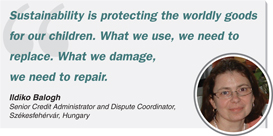
In 2008, we completed the first substantial forest restoration work at the new Juruti mine that opened in Brazil’s Amazon region in 2009. Clearing for the Juruti mine’s development has had some unavoidable impacts on native wildlife and
| Visit www.alcoa.com/sustainability for more information on policies, programs, actions, and performance data. | ||
| 12 |
Sustainability of Resources (continued)
habitat. A team of field biologists, working in collaboration with a local museum, was based at the site to oversee the rescue and translocation of affected animals. Snakes, lizards, sloths, and monkeys were translocated as a result of this effort.
Mining Land Disturbed/Land Rehabilitated
Hectares
| Open Mine Area Cumulative |
Area Disturbed Annual |
Area Rehabilitated Annual | ||||
| 2000 |
7,626 | 995 | 1,172 | |||
| 2005 |
7,688 | 2,097 | 1,276 | |||
| 2006 |
7,468 | 1,235 | 1,634 | |||
| 2007 |
7,291 | 1,451 | 1,056 | |||
| 2008 |
7,756 | 1,445 | 974 | |||
| 2009 |
15,494 | 1,244 | 627 |
Open mine area is the cumulative area of land that has not been rehabilitated (including active mines and land used for mining infrastructure). Area disturbed means annual land used in each reported year for mining or for mining infrastructure (roads, shops, crushing equipment, conveyors). Area rehabilitated means annual land returned to nature or to productive use (such as farming) after mining or decommissioning of mine infrastructure in each reported year. One hectare equals approximately 2.5 acres.
In 2009, Alcoa acquired BHP Billiton’s holding in Suriname, including mines that were operated as part of a joint venture. This has added significantly to the open mine area. Development of the Juruti mine in Brazil has also resulted in a significant increase in open mine area in the South American region.
BIODIVERSITY
We actively endorse the concept of conservation of biodiversity by operating worldwide in a manner that minimizes effects on natural habitats and biological resources.
One of our challenges is to measure our performance on biodiversity management. We have an aspirational goal to provide a net positive impact on biodiversity everywhere we operate, but we have, as yet, been unable to develop a common, quantifiable biodiversity goal globally.
We plan to develop a requirement for all of our locations with substantive land holdings to develop biodiversity management plans by 2015. These plans will:
| • | Identify the biodiversity values of the land, including sensitive habitats and presence of threatened species, in context with surrounding land; |
| • | Identify potential impacts, both positive and negative; |
| • | Develop a management plan based on the hierarchy of biodiversity mitigation measures—avoid > minimize > rectify > compensate; and |
| • | Set and report performance against site-specific targets. |
During 2009, difficult financial circumstances slowed progress on this initiative. However, we began piloting biodiversity management plans at two locations, seeking advice from stakeholders and consulting with site personnel.
WATER CONSERVATION
At Alcoa, we reinforce the concept that water is a key raw material that must be managed closely in terms of availability and cost. Our efforts to reduce water use are based on a risk priority plan to take action first in regions where the issue is most sensitive. Our highest priority is currently in Australia, where the long run of reduced rainfall has considerably raised awareness of the need for water conservation.
We also continue to target the processes (refining and ingot casting) that use the most water on a relative basis. While our refineries in Western Australia attempt to capture and reuse as much water as possible, we are evaluating methods to capture water (and heat) lost through evaporation in production. For our ingot casting operations, we continue to explore innovative and more efficient water-recycling applications.
We are also re-evaluating quality requirements to assess the validity of using secondary sources of water in our processes. This will reduce both the need to extract freshwater and discharge water to the environment, giving us time to explore process changes that might lead to reduced water demand overall.
CONSERVATION INVESTMENTS
Alcoa and Alcoa Foundation fund projects designed to conserve natural resources around the world.
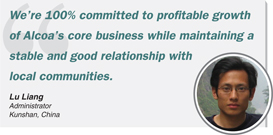
For example, we are supporting Conservation International’s effort in Suriname to build the capacity of
13
Sustainability of Resources (continued)
researchers in the Werehpai Sanctuary in the south to monitor carbon stocks and assess biodiversity. The data and findings are shaping the natural resource management policies and practices of indigenous leaders and community stakeholders in Kwamalasemutu and the government of Suriname.
In Brazil, Conservation International do Brasil (CI-Brazil) is using a five-year Alcoa Foundation grant (US$705,000) to establish protected areas in the Tapajós-Madeira Nucleus, one of the most important sectors of the Southern Amazonia Biodiversity Corridor. Lessons learned from this project will be used to expand the biodiversity corridor into other protected areas along the Tapajós-Madeira Nucleus.
PURCHASING STANDARDS
In an effort to better understand and evaluate our supply base’s sustainability awareness and practices, we initiated two pilot supplier sustainability processes in 2009—one in Canada, and one in Latin America.
The Canadian process focuses on local, non-strategic suppliers and is intended to help our suppliers develop sustainability programs that align with Alcoa’s sustainability initiatives. The Latin American process focuses on finding the balance between low cost and high social/environmental commitment. We will evaluate the results of both pilots in 2010 as input to our global program.
We are also working on the development of a global supplier sustainability process to help assess sustainability awareness and maturity across our strategic raw material and energy suppliers. During 2010, we will collect information from these key suppliers and assess their progress and gaps in sustainability areas that are critical to Alcoa. Where needed, we plan to offer training to enable these suppliers to better align their sustainability programs with ours.
SECURITY OF SUPPLY
Ensuring continuity of supply for critical materials is one of our key focuses, and we faced unprecedented challenges during 2009. As part of our Cash Sustainability Program, we were challenged to deliver spend reductions totaling US$1.5 billion while we were also curtailing capacity and changing input volumes in certain areas of the world.
To meet this aggressive financial goal, we had to look beyond traditional sources of supply to more competitive sources. We also monitored our existing supply base for financial stability, on-time delivery performance, and supply quality issues to identify any areas for concern. Through these efforts, we exceeded the US$1.5 billion spend reduction target by US$500 million with no interruption of production or deliveries to Alcoa customers as a result of supply changes.
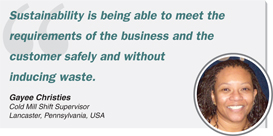
COMPETITIVE PRICING
In 2009, the aluminum market saw unprecedented high inventory levels and low pricing. In response, we placed a singular focus on cash conservation and implemented our Cash Sustainability Program early in the year.
To deliver on the aggressive targets, our leadership created spend reduction teams (SRTs) that were co-led by procurement and business unit leadership. Team members met with suppliers to discuss the dramatic commodity price declines and the challenges Alcoa faced in 2009. Significant price reductions and spend leveraging were achieved, and we identified hundreds of productivity initiatives across the supply chain. These initiatives enabled us to radically change the market price for critical raw materials.
At one U.S. plant, for example, summits with construction contractors resulted in US$405,000 in savings and US$100,000 in working capital impact. In the United States and Canada, our waste disposal team developed baselines for current costs and volumes at each location and built a bid template to capture all required information. Bids at 12 locations yielded savings of more than US$1.2 million.
| Visit www.alcoa.com/sustainability for more information on policies, programs, actions, and performance data. | ||
| 14 |
| Sustainability of Operations |

|
Alcoa is a worldwide, fully integrated aluminum producer with operations across the entire spectrum of the aluminum industry. Each operation faces significantly different challenges as it evolves and deploys initiatives that lead to sustainability. Each also requires a comprehensive sustainability approach to operations in order to earn and sustain our license to operate every day.
Operational sustainability for our mining, refining, and smelting operations focuses principally on managing our carbon and environmental footprints. Current refining and smelting processes also generate carbon dioxide emissions and carbon waste byproducts. Existing refining processes also require significant quantities of water and generate bauxite residue waste.
From a relative perspective, the environmental impact of the fabricating side of our businesses is significantly less than our mining, refining, and smelting businesses. Nonetheless, sustainability of these downstream businesses requires that we focus on reducing our water use, emissions, and waste generation.
Maintaining our license to operate in every facility and in every jurisdiction requires utmost attention to the health and safety of our employees and contractors, who are the backbone of our production organization. We also value the diversity that is inherent in our global workforce and ensure each employee has the opportunity to achieve success.
We respect every community in which we operate, and we engage early and often with all interest groups within those communities to build strong, interdependent relationships. We also understand the importance of the economic value we generate in the communities where we operate. The economic leg of our sustainability approach has been one of the most difficult aspects of our operational sustainability since the global collapse in late 2008.
In 2009, we faced significant financial challenges worldwide. The U.S. dollar continued to weaken against other currencies, and we were significantly affected by the unprecedented decline in the global price of aluminum.
These extraordinary circumstances required us to take extraordinary actions. Some of our locations reduced employment levels significantly, some were idled completely, and others were permanently shuttered. These painful counter-measures serve to remind us that our local facilities are all connected to, and competing in, a global marketplace where low costs and consistently high product quality are keys to survival.
CLIMATE CHANGE
Although great activity concerning climate legislation occurred in 2009, the year unfortunately concluded with perhaps even greater uncertainty around the potential for a binding global agreement. The same was true for legislation in key regions where Alcoa operates. Despite this uncertainty, we continued taking a leadership stand on climate change within our industry and remained actively engaged on the issue globally.
We have been a leader in addressing the issues of climate change for nearly two decades. In the early 1990s, we made our first voluntary GHG reductions. In 1998, we established a Climate Change Strategy Team that developed and promoted our first position on climate change, including our initial target of reducing direct greenhouse gas emissions by 25% below 1990 levels by 2010. We achieved that goal in 2003, seven years ahead of schedule. Our new target is a 20% reduction in total carbon dioxide equivalent (CO2 ,e) intensity by 2020 and 30% by 2030 from a 2005 baseline.
Key actions on climate change in 2009 included the following:
| • | We worked diligently with legislators in each region to ensure that the significant benefits of aluminum and aluminum products can and should play a key role in climate solutions; |
| • | An Alcoa representative attended various sessions to gather information surrounding the policy debate at the United Nations Climate Change Conference in Copenhagen, and Alcoa Foundation supported the Council on Foreign Relations to convene an international symposium to discuss climate change policy issues following the conference; and |
| • | We continued to reduce our absolute greenhouse gas emissions, achieving a 44% reduction from 1990 levels. This compares to a reduction of 36% through the end of 2008, although a considerable portion of the 2009 improvement was due to production curtailments. This idled capacity my be restarted when overall market conditions warrant. |
As an indication of our commitment to reducing our GHG footprint, we are, for the first time, including an annual
15
Sustainability of Operations (continued)
reduction target as a component of our 2010 incentive compensation program. The target is derived from the CO2,e reductions that will result from reducing perfluorocarbons (PFCs) in our smelters, as well as incremental energy efficiency from all other operations.
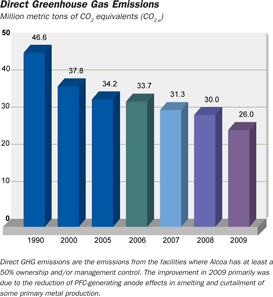
WATER
The economic situation in 2009 did not allow us to invest capital in water reduction projects. However, we did look for non-capital measures, especially in regions where the sensitivity to water availability is greatest.
In Australia, for example, we have evaluated a number of applications that might greatly reduce the evaporation of stored water so that more is available for re-use. We also have evaluated secondary sources of water that can be used in our processes and still allow us to meet product-quality requirements.
Our overall reduction in freshwater use versus 2000 levels improved to 29% in 2009, but this result was impacted by the curtailment of some of our primary metal production.
While this was certainly short of our objective of a 70% reduction, we believe that it is still significant given our roughly doubled production over that same period of time. Our new long-term goal will focus on fresh water use intensity within each business. From a 2005 baseline, each business is challenged to reduce average water-use intensity 10% by 2020 and 25% by 2030.
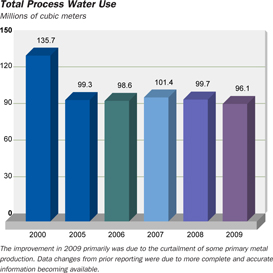
HEALTH & SAFETY
At Alcoa, we strive to work safely in a manner that protects and promotes the health and well-being of our employees, contractors, and the communities in which we operate because it is fundamentally the right thing to do. We establish and track long-term and incremental targets to quantitatively monitor progress toward achieving our long-standing goal of zero work-related injuries and illnesses.
The following achievements in 2009 helped move us closer to that goal:
| • | We updated and expanded our health and safety goals in Alcoa’s strategic sustainability targets; |
| • | We established a new Global Health Committee (GHC), made up of representatives from all regions and business units, to serve as a forum for the exchange and vetting of ideas that emanate from either corporate representatives or the locations; |
| • | We launched an Environmental Health Lead Team to develop better awareness and guide improved response capability for addressing environmental health issues in the communities in which we operate; and |
| Visit www.alcoa.com/sustainability for more information on policies, programs, actions, and performance data. | ||
| 16 |
Sustainability of Operations (continued)
| • | Our locations posted a 26% reduction in overall hours worked and a 67% improvement in the 12-month rolling average of lost workdays. |
This progress was marred by the disappointment and tragedy associated with two employee fatalities and two contractor deaths during the year.
Incident Rates
| Lost Workday Incident Rate |
Total Recordable Incident Rate | |||
| 2005 |
0.12 | 1.47 | ||
| 2006 |
0.11 | 1.38 | ||
| 2007 |
0.12 | 1.46 | ||
| 2008 |
0.12 | 1.34 | ||
| 2009 |
0.13 | 1.28 |
Lost workday (LWD) incident rate represents the number of injuries and illnesses resulting in one or more days away from work with or without days of job transfer or restrictions per 100 full-time workers. Total recordable incident (TRI) rate represents the number of injuries and illnesses resulting in days away from work, job transfer or restriction, medical treatment, or other recordables per 100 full-time workers.
OUR PEOPLE
Our people are the foundation of our success throughout the world. Our goal is to attract, develop, and retain the best talent and create an environment that enables each employee to contribute to our collective success. This goal is especially challenging and critical in today’s turbulent economic times.
In 2009, the global recession had a significant impact on our company. We were forced to curtail operations in many parts of the world and divest some downstream businesses. Regrettably, these actions resulted in headcount reductions that impacted 9,300 employees during the year. We also instituted a global salary freeze in 2009.
We continued many of our existing human resources programs and added others during the year. We launched a company-wide mentoring program to foster a solid partnership between senior leaders and more junior talent. We also replaced our Learning Express learning management system with AlcoaLearn, an enhanced, multilingual (22 languages), intuitive, web-based tool. The system is available to more than 50% of our global hourly and salaried employees and will be available to all employees by the end of 2010. In addition, we began revamping our leadership development programs to more closely address the changing needs of our workforce.
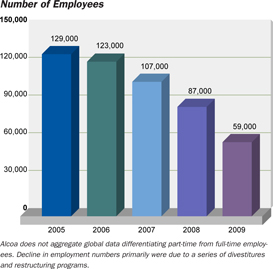
COMMUNITY
The volatile economic climate in 2009 significantly changed Alcoa’s business and considerably affected those around us. Through these difficult times, we were ever mindful of the economic and social implications of our business decisions on local communities and continued to work in partnership with those around us as we navigated the challenges.
Through the Alcoa Community Framework, Alcoa and Alcoa Foundation continued to work with the communities in which we operate to develop partnerships with community organizations, fund projects designed to address priority community needs, and contribute to the sustainability of each community.
In 2009, the combined giving of Alcoa and Alcoa Foundation reached more than US$34 million. Alcoa Foundation provided more than US$16.2 million in grants in 27 countries where Alcoa operates, with Alcoa and Alcoa-related foundations contributing another US$18.4 million to support projects and partnerships with non-governmental organizations around the world.
More than 50% of the US$34 million was for resources directed at building resilience to enable communities to emerge stronger from the downturn and address pressing environmental sustainability challenges. Funded programs focused on building capacity to respond to the increased
17
Sustainability of Operations (continued)
demand for basic services, skills development, workforce development, and job placement initiatives.
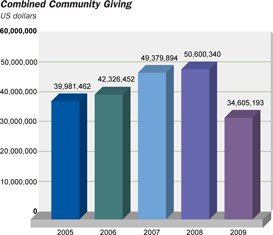
As resources were stretched and community need was heightened in 2009, we placed an intensive focus on strengthening and broadening our employee volunteer effort to deliver greater impact in our local communities. This company-wide effort resulted in record employee involvement in all three of our volunteer service programs.
We also continued the rollout of the Alcoa Community Framework in Africa, Asia, the Caribbean, Europe, and South America. About 90% of our worldwide operating locations had established community programs at year end.
STAKEHOLDER ENGAGEMENT
Alcoa does not exist in a vacuum, which is why we require our operating locations to conduct meaningful stakeholder engagement. The locations are free to determine the most effective means for achieving this within the collaborative relationships of their own stakeholder bases.
In 2009, our emphasis continued to be the pursuit of earlier input from stakeholders in the communities where we operate—not just for our growth projects, but also for existing plant upgrades, expansions, and ongoing activities.
In similar fashion with other stakeholders, we try to develop a constructive dialogue with non-governmental organizations (NGOs) to ensure that we understand their interests and concerns regarding our operations and to determine whether we can work together to address them.
We have developed very successful partnerships with numerous NGOs to focus on issues that are critical to Alcoa’s long-term sustainability. These include:
| • | Pew Center on Global Climate Change: Alcoa Foundation’s Make an Impact Program was launched across the United States in 2008 through a partnership with the Pew Center on Global Climate Change. |
| • | World Resources Institute: Alcoa and Alcoa Foundation are working with World Resources Institute to support research to inform and provide input to the U.S. and international policy communities as they develop a global regime to address climate change and advance sustainable development. |
| • | Resources for the Future: Alcoa and Alcoa Foundation are working with Resources for the Future to support the development of policy approaches and engaging stakeholders and policymakers on the domestic and international issues underpinning legislation focused on climate change and greenhouse gas emissions. |
| • | Conservation International: Alcoa and Alcoa Foundation are working with Conservation International in both Brazil and Suriname to ensure the biodiversity of the regions that are being impacted by Alcoa operations. |
We recognize that all NGO relationships cannot be partnerships. Effective and productive relationships require that both sides be committed to working together to clarify and prioritize the issues and share responsibility for desired outcomes and success.
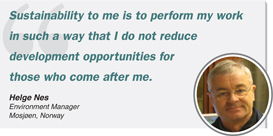
| Visit www.alcoa.com/sustainability for more information on policies, programs, actions, and performance data. | ||
| 18 |
Sustainability of Operations (continued)
FINANCIAL PERFORMANCE
In 2009, we were confronted with the challenge of preserving Alcoa’s future while navigating the company through a global economic downturn. This crisis triggered an unprecedented decline in London Metal Exchange (LME) pricing levels, which began in the second half of 2008, and a collapse in demand from aluminum product end markets.
We adopted a holistic response to this situation by initiating various actions, including: curtailing additional refinery and smelter capacity (necessitating further layoffs); instituting programs to identify procurement efficiencies, overhead rationalization, and working-capital improvements; reducing the quarterly common stock dividend; and issuing new equity and debt instruments. All of these actions were aimed at reducing costs, improving cash levels, and preserving liquidity.
Our 2009 financial performance included the following:
| • | Sales of US$18.4 billion; |
| • | US$985 million loss from continuing operations, or US$1.06 per diluted share; |
| • | Cash from operations of US$1.4 billion and cash on hand at the end of the year of $1.5 billion, almost double the level at the end of 2008; |
| • | US$759 million reduction in total debt and a debt-to-capital ratio of 38.7%, which was a 380 basis point improvement from 2008; and |
| • | Capital expenditures of US$1.6 billion, a more than 50% reduction from 2008. |
In 2010, we expect market conditions for aluminum products in certain end markets, particularly automotive and commercial transportation, to improve (Alcoa analysis as of early 2010). Other markets, including aerospace, building and construction, and industrial gas turbines, are expected to decline. We also project an increase in the consumption of primary aluminum, especially in China. On the cost side, increases in energy prices and continued currency movements are expected to be a challenge.
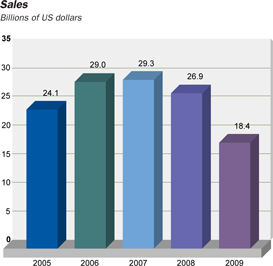
19

Alcoa World Headquarters
390 Park Avenue
New York, NY 10022
USA
Phone: 1 212 836 2600
Fax: 1 212 836 2818
Internet: www.alcoa.com
Online sustainability reporting:
www.alcoa.com/sustainability
To provide feedback on Alcoa’s sustainability report,
please send an email to sustainability@alcoa.com
or a letter to Alcoa Inc., 201 Isabella Street,
Pittsburgh, PA 15212, USA.
